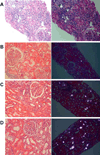Subclinical celiac disease and crystal-induced kidney disease following kidney transplant
- PMID: 22739230
- PMCID: PMC4469185
- DOI: 10.1053/j.ajkd.2012.02.342
Subclinical celiac disease and crystal-induced kidney disease following kidney transplant
Abstract
Decreased kidney function from kidney deposition of calcium oxalate has been described previously in inflammatory bowel disease and after jejuno-ileal and Roux-en-Y gastric bypass surgeries. Although celiac disease is the most prevalent bowel abnormality associated with intestinal malabsorption, its relationship to high kidney oxalate burden and decreased kidney function has not been established. We report a case of subclinical celiac disease and hyperoxaluria that presented with loss of kidney function as a result of high oxalate load in the absence of overt diarrhea, documented intestinal fat malabsorption, and nephrolithiasis. Subclinical celiac disease is commonly overlooked and hyperoxaluria is not usually investigated in kidney patients. We propose that this entity should be suspected in patients with chronic kidney disease in which the cause of kidney damage has not been clearly established.
Published by Elsevier Inc.
Figures



References
Publication types
MeSH terms
Substances
Grants and funding
LinkOut - more resources
Full Text Sources
Medical
Research Materials

